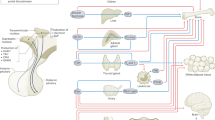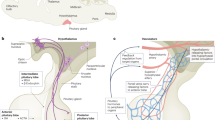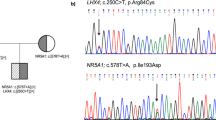Abstract
MY earlier investigations on the neural gland of tunicates may perhaps throw some light on the origin of the pituitary body in vertebrates. I have adduced evidence1–4 that the neural gland (plus ciliated pit) of tunicates is the homologue of the vertebrate pituitary body. The mouth of the ciliated pit, then, is the homologue of the opening of Rathke's pouch, and as such does not enter into the structure of the pituitary proper. The stage in the development of the tetrapod pituitary at which Rathke's pouch is open is thus a ‘recapitulation’ of a phylogenetic step, still extant in ascidians.
This is a preview of subscription content, access via your institution
Access options
Subscribe to this journal
Receive 51 print issues and online access
$199.00 per year
only $3.90 per issue
Buy this article
- Purchase on SpringerLink
- Instant access to full article PDF
Prices may be subject to local taxes which are calculated during checkout
Similar content being viewed by others
References
Carlisle, D. B., Pubbl. Staz. Zool. Napoli, 22, 192 (1950).
Carlisle, D. B., Nature, 166, 737 (1950).
Carlisle, D. B., J. Exp. Biol., 28, 463 (1951).
Carlisle, D. B., Quart. J. Micr. Sci., 92, 201 (1951).
Carlisle, D. B., Pubbl. Staz. Zool. Napoli, 22, 146 (1950).
Author information
Authors and Affiliations
Rights and permissions
About this article
Cite this article
CARLISLE, D. Origin of the Pituitary Body of Chordates. Nature 172, 1098 (1953). https://doi.org/10.1038/1721098a0
Issue date:
DOI: https://doi.org/10.1038/1721098a0
This article is cited by
-
The neural gland in tunicates: fine structure and intracellular distribution of phosphatases
Zeitschrift f�r Zellforschung und Mikroskopische Anatomie (1971)



